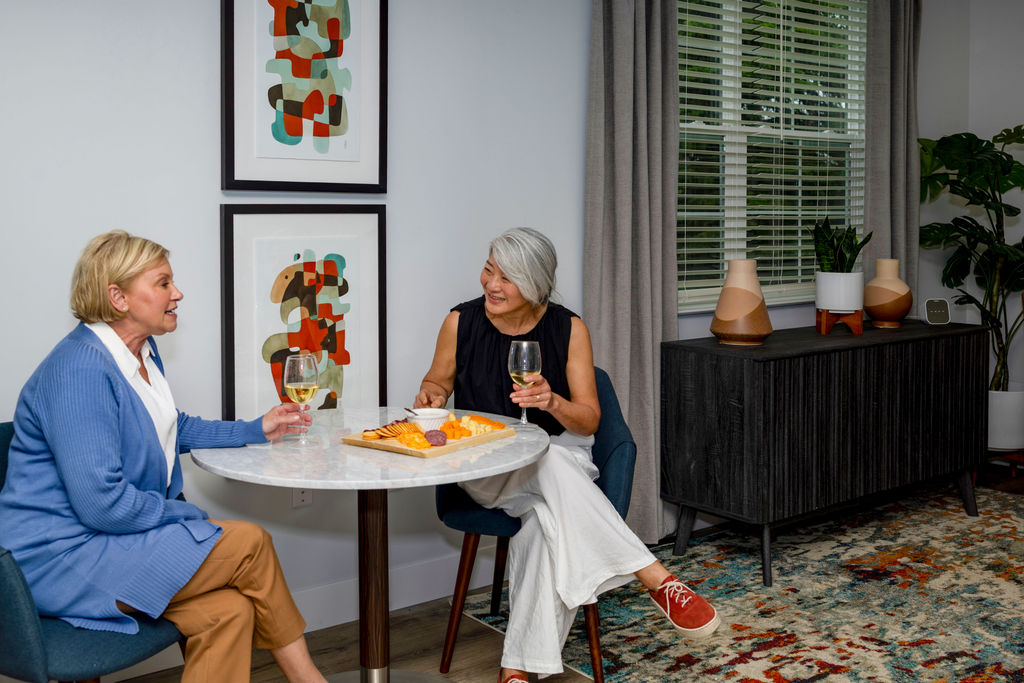The concept of retirement is an exciting prospect. For many people, it’s a season of life that’s highly anticipated well before retirement age is ever reached.
People invest many years of their lives into growing professions and raising families. The amount of energy required to balance it all out makes it quite simple to maintain an active lifestyle while working.
Then comes the day when it’s finally time to leave the workforce once and for all. The thrill of reaching this milestone is often paired with a desire amongst retirees to simply want to take some well-earned time to relax and unwind. It’s common to hear retirees talk about the joy of being able to do absolutely nothing for once!
For many people, there’s a sense of finally being able to focus on hobbies that have long been put on the back burner. It may well be the first time life is without a set schedule, family demands, or work expectations in place.
Stopping the rush and slowing down feels refreshing . . . for a while. Then reality and boredom set in. Many retirees find themselves wondering what to do next quicker than they imagined they ever would.
- Don’t Overlook the Importance of an Active Retirement Plan
- How to Have an Active Retirement
- Recognize What’s Most Important in Achieving an Active Retirement
- Consider Your Living Arrangements
Don’t Overlook the Importance of an Active Retirement Plan

In rushing towards the goal of retirement, many people focus exclusively on that elusive concept of free time. They completely overlook how important it is to plan for an active retirement and plan how they’ll spend all that free time.
An active retirement is one that treats this season as an opportunity and not an ending. It’s a chance for independent people with unique personalities to continue to grow skills, passions, and hobbies outside of the workforce—and with a renewed sense of purpose.
Of course, there’s nothing wrong with taking some time to indulge those desires to do nothing for just a while. However, most retirees will find that this approach gets pretty boring fairly quickly.
It’s especially true for those who are used to maintaining a high-energy schedule. The shift from having a packed calendar to having a completely open schedule can be jarring and even disorienting.
Many retirement activities sound appealing on the surface. Spending all day reading for example, or knitting, woodworking, and bird-watching can be fun for a while. These activities can be far less appealing when they become the limit of your daily options.
Fortunately, boredom doesn’t ever have to remain a standard in life—especially not in retirement. Planning for an active retirement is ideal when a career has come to a close and it’s time to step into a new phase.
Those who plan for an active retirement aren’t sacrificing anything in the way of rest. Instead, they’re redirecting their energies toward activities, choices, and people that are engaging and revitalizing!
It begins with expanding your retirement priorities. When you’re looking to maintain an active lifestyle in retirement, you’ll have to pursue environments where like-minded people connect, engage in new activities together, and focus on improved wellness at every turn.
An active retirement truly revolves around growth and community. It’s rarely about retirement activities that are undertaken solo, but about finding meaningful relationships with others in the same season of life who want to remain active, too.
How to Have an Active Retirement
It’s important to remember that planning for an active retirement isn’t simply coming up with a list of things to do each day that keep you busy all the time. There’s an enormous difference between doing something to keep boredom at bay and pursuing a life filled with a renewed sense of purpose.
Finding retirement activities that engage your mind and body is vital to a successful and active retirement. A lineup of quality activities built into daily life is sure to be more satisfying than those sprinkled into a schedule simply to pass the time.

Make Long-Term Goals
Activities that take long-term goals into account are often great for those looking to enjoy a healthy and active retirement experience. In our modern world, retirement isn’t necessarily a small amount of time within our lifespan. It has the potential to be a significant and extended season of life!
That said, when you want to maintain an active lifestyle through this part of life, you need to focus on the long-term. Keeping your mind and body sharp starts with taking up activities that take time, concentration, and practice. In this way, there’s always more to learn and milestones to look forward to.
Options like taking up a musical instrument or learning a new language are great examples of this type of long-term activity. Pursuing activities of this type can help with increased brain function, connect you with those around you enjoying similar activities, and give you a skill set that can always be expanded upon.
Remain Up for a Challenge in Retirement
During our working years, we are conditioned to think the most challenging part of life revolves around the professional hurdles we face. Climbing that corporate ladder, getting to the next pay grade, and supporting our families financially takes a certain amount of creativity, flexibility, and courage.
There’s absolutely no reason those same goals and attributes can’t be applied to an active retirement. When things are too easy, human beings have a funny way of getting complacent quickly.
Ultimately, it’s a challenge that drives us forward. When we’re forced to deal with more difficult situations, it innately sharpens our problem-solving skills and helps us think creatively. Perspective and growth tend to follow in the wake of all this.
Leaving professional endeavors behind doesn’t mean retirement needs to be without its positive challenges. Don’t be afraid to take on something that seems a little scary or new in this phase of life. The results almost always work out for the best!
Pursue What You’re Passionate About

One of the most invigorating aspects of planning for an active retirement is the idea that this phase of life is an entirely blank slate. If you weren’t particularly passionate about the career you had for many years, this is a season in which you have an opportunity to pursue something you truly love.
At its essence, retirement really is a time to do what you want. While that kind of freedom can feel overwhelming at first, taking time to step back and evaluate your skill set and those things you’ve long wanted to try is endlessly exciting, too!
Without the limits of the professional workplace to lock you in, an active retirement is a time to dig into what drives you in life. Perhaps there’s a place you’ve always wanted to see or an unmet goal that’s lingered in the back of your mind. Now is the time to make those wishes a reality.
Invest in Others
While an active retirement is very much about growing and thriving in a new season, it’s also an opportunity to invest in others. During our working years, it can seem hard to find the time to give back when we’re so busy trying to maintain our own lives and families.
In retirement, schedules open up, allowing perspective to change, too. Giving back is a good way to explore your personal gifts that have the power to impact others positively.
For some retirees, this may take the form of signing up for a volunteer trip to another country. For others, it could be as simple as spending time volunteering at a local shelter or soup kitchen. The size of the gesture isn’t as important as the motivation behind the act.
There are even ways to combine new skills with giving back that leave you with an inspiring sense of purpose. Those taking up activities like sewing, knitting, crochet, or woodworking might consider donating their creations to organizations that distribute them to people in need.
Recognize What’s Most Important in Achieving an Active Retirement

Throughout the majority of our lives, it feels like there’s some sort of set trajectory to follow. Education, professional goals, and the needs of the family tend to act as guide rails for how we move forward. Retirement can feel very different.
Many retirees are surprised at how the freedom and unstructured nature of this phase of life leaves them wondering what the next step is. It’s easy to feel overwhelmed by the sheer amount of possibility and lack of limits.
That’s what makes planning for an active retirement so important. Retirement isn’t something that comes with a clear set of guidelines but instead looks exceptionally different for everyone experiencing it.
Having others weigh in on the planning is key to success. It’s also vital to strengthening your support network in a time when everything seems so new!
It’s important to lean on friends and family when you’re planning for an active retirement. They’ve likely been a huge influence throughout the rest of your life, so there’s no reason to eliminate them from the equation now.
Be open to having honest conversations with these individuals about how you want to approach retirement. Their emotional support will inevitably contribute to your overall health and happiness, and their insight could prove essential when it comes to putting the right retirement plan in place.
Your family and friends will give you honest feedback on your idea for retirement and will likely have some helpful advice, too! Talking things through early on lets them know they’re important to you and even allows you to make a regular schedule for visits and adventures that should be part of your plan as well.
Consider Your Living Arrangements
While some people find themselves highly motivated in retirement to pursue an active lifestyle, others know they’ll need more structure to make that happen. Making it a point to consider your living arrangements in retirement is going to be a top priority when an active retirement is the goal.
Both emotional and physical factors should be taken into consideration when it comes to deciding whether or not to remain at home or join asenior living/55 plus community. Some retirees find staying at home to be motivating, while others look forward to joining a community of others who are living through the same phase of life.
Those who have a well-established social network in place and are certain of the activities they want to pursue in retirement will likely thrive at home. However, the many benefits of a senior living/55 plus community shouldn’t be overlooked.
Individuals concerned with any physical or health conditions will likely find a sense of comfort and relief in deciding to move into a senior living/55 plus community. These welcoming communities are designed to provide independent living options in apartments paired with access to health professionals when needed.
On-site staff members are well-versed in caring for residents and helping with daily tasks upon request. If a transition ever needs to be made to a community with more in the way of medical care, assistance is available. Options to enjoy transportation to and from appointments takes the hassle and worry out of driving—giving residents and their families peace of mind.
Senior living communities specialize in integrating a variety of fun and engaging activities into the daily lives of their residents. This is a major bonus for those seeking an active retirement who also know they’ll benefit from scheduled events.
These communities create active retirement standards for residents through planned activities, excursions, and social events everyone can look forward to. Many senior living communities also provide residents with access to lectures, on-site performances, art classes, dance events, and more.

While shopping outings, organized socials, and fun events seamlessly create a sense of community, active retirement also means maintaining a sense of independence for the vast majority of retirees. Senior living communities cater to this by offering residents their own apartments and providing on-site amenities to pick and choose from daily.
Communities that include spacious dining halls run by exceptional chefs, visiting areas for families, fitness centers, theaters, and more make it simple to keep that sense of independence alive and well intact. Achieving an active retirement looks different for everyone, and options are key to success.
While making the most of an active retirement could mean traveling the world to one person, another retiree may find their freedom in simply being able to spend an afternoon at the on-site salon their living community hosts. Either way, a customized experience makes this season of life a well-earned adventure.





